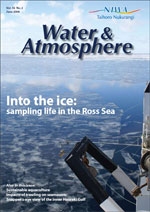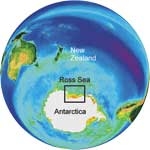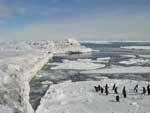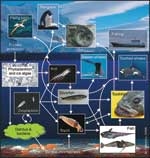PDF of this article (230 KB)



Matt Pinkerton, Janet Bradford-Grieve, and Stuart Hanchet are developing a mass-balance model to learn how animals fit together in the Ross Sea ecosystem.
After braving some of the worst sea ice in decades, NIWA scientists returned in late March from a seven week voyage to the Ross Sea region of Antarctica. Among our goals for the voyage was to learn more about the region’s predator–prey links and the abundance of some important and poorly understood species.
Antarctica's unique ecosystems
Compared to temperate regions, the waters of the Southern Ocean have low primary productivity – the production of organic matter by plants that is the basis of marine food webs. In temperate waters, like those around New Zealand, phytoplankton grows during most of the year. But in the Ross Sea there’s a long period between late May and mid July when the region is in 24-hour darkness and no plants can grow. The year’s entire primary production happens in brief events in the spring and summer, and these bursts of high productivity are often very localised. Another challenge for Antarctic animals is the dramatic change through the year to the available environment, as sea ice forms in the autumn and then melts in the spring.
These special conditions seem to be associated with particular characteristics in Antarctic animals and plants. Animals living in Antarctic waters have a relatively low number of species and many are endemic to the region; that is, they don’t live anywhere else and are highly specialised to the Antarctic conditions. Some species of fish have developed antifreeze in their blood that allows them to survive in freezing conditions. And Antarctic organisms are often larger and slower-growing than similar animals in warmer waters.
Survival strategies
Animals living in the Ross Sea have developed various strategies for survival when food is scarce. Entire populations of some of the larger, mobile animals leave the region completely during winter, including minke whales, most seals, petrels, and Adélie penguins. Some larger animals tough it out, relying on having built up enough reserves to see them through. Emperor penguins, for example, incubate their egg over winter to take advantageof the plentiful food in the spring and summer when it’s time to feed the newly hatched chicks. This is a risky strategy: while incubating the egg through the winter, the males lose more than 40% of their body weight and come close to starvation. Other less mobile organisms store oil in their body during the summer and use this for energy while in a quiescent (low-energy) stage during winter. Still other animals have expanded the things they can eat, live slower but longer, or can adjust their breeding cycles to take advantage of occasional peaks of food availability.
Modelling a mass-balance food web
At NIWA we’re fitting together what’s known about the Ross Sea ecosystem into a consistent picture. Data about the ecosystem have been produced over many years by a number of nations and it has been a mammoth task to pull all this information together and make sense of it. We have particularly been interested in data that measure the quantity of organisms (biomass), the amount of food an animal needs to survive and grow, the rate at which it grows, and how the numbers of predators and prey affect each other.
To confirm our understanding of how the food web works, we’re developing a mass-balance model of the Ross Sea. The model is based on the balance between growth and death in various groups of animals over time. We know that no more production can come out of the Ross Sea system than is put in by the primary producers,and that there will be losses in biomass at each link in the food web.
Some aspects of the ecosystem are quite well known, while other pieces need new data or, failing this, force us to make educated guesses. New research becomes available all the time, so this is a constantly shifting target. The model checks that the available numbers make sense when put together.
Last year we presented a preliminary balance model to CCAMLR (the commission that implements the Convention on the Conservation of Antarctic Marine Living Resources), who regulate fishing in the Antarctic. We’re using our model to help investigate how the organisms fit together in the ecosystem and to decide which are the important questions for future research. The model should also suggest potential impacts on the Ross Sea ecosystem of fishing, climate variability, and climate change.
Finding a balance
- The animals, plants, and microbes of the Ross Sea ecosystem haveunique survival strategies to meet the particular challenges of theirenvironment.
- NIWA scientists are fitting together what is known about the Ross Sea ecosystem to model a mass-balance food web.
- The 2008 research voyage will add vital pieces to the puzzle, especially on the biomass and feeding relationships of larger animals that are difficult to catch.

The big picture: a simplified Ross Sea food web
Growth of phytoplankton makes up the largest contribution to primary production in the region, though there is some primary production by seaice algae and macroalgae (seaweed). Bursts of growth occur in the spring and summer along the coast, in polynya (large open-water areas within the sea ice), and in the waters left as the sea ice melts. Primary production is channelled through copepods, the most common type of zooplankton, and a number of smaller species of zooplankton. Algae that are not consumed and waste products can fall to the seafloor, often in large amounts. This food source, and the growth of macroalgae in coastal regions, provides nutrition for the benthic (bottom-dwelling) invertebrates. These benthic animals have varied feeding strategies and include:
- grazers, such as urchins, sea cucumbers, and snails
- predators, such as the Antarctic whelk and seastars
- filter-feeders, such as Antarctic scallops, bivalves, anemones, soft corals, and sponges
- scavengers, such as large worms.
Two species of krill are found in the Ross Sea: the larger Antarctic krill north of the Ross Sea proper, and smaller crystal krill in waters over the continental shelf to the south. Krill abundance tends to be much lower in the Ross Sea than in other parts of the Southern Ocean, and Antarctic silverfish fill the gap as key species in the food web. Silverfish grow to a length of about 30 cm, occur throughout the Ross Sea, and are found in the diet of almost all large predators. They, in their turn, feed on the smaller copepod crustaceans. Other fish in the Ross Sea include the 2-m-long Antarctic toothfish, ‘cryopelagic’ fish that live on the underside of sea ice (cryo=freezing, pelagic=open waters), as well as grenadiers (or rat-tails), skates, deepsea and moray cods, dragonfishes, and icefishes. A number of species of squid and octopus live in the Ross Sea, including the colossal squid that can grow to more than 4 m long.
In the Ross Sea region, there are an estimated 40 000 breeding pairs of emperor penguins and about 1 million breeding pairs of Adélie penguins (38% of the world population). Several other species of birds breed in the region,including Antarctic petrels, snow petrels, and the south-polar skua, which preys on penguin chicks. Many other birds visit in summer, including two albatross species.
Seals are the most common marine mammals in the Ross Sea in summer, with more than 200 000 crabeater seals, 40 000Weddell seals, 8000 leopard seals, and 5000 Ross seals. Baleen whales in the outer Ross Sea include dwarf minke whales, Antarctic minke whales, and smaller numbers of fin, humpback, sei, and blue whales. Toothed whales sighted in the Ross Sea include orca (killer whales), sperm whales, southern bottlenose whales, and Arnoux’s beaked whales.
Further reading and useful links
Hanchet, S.; Judd, W. (2006). The Ross Sea toothfish fishery. New Zealand Geographic 79: 16–20.
Pinkerton, M.H.; S. Hanchet; J. Bradford-Grieve. (2007). Finding the role of Antarctic toothfish in the Ross Sea ecosystem. Water & Atmosphere 15(1): 10–11.
Scott, M. (1991). Antarctica, a New Zealand perspective. New Zealand Geographic 9: 52–83.
Dr Matt Pinkerton is a specialist in remote sensing and modelling food webs, and Dr Janet Bradford-Grieve is a marine biologist and ecologist. They are based at NIWA in Wellington. Dr Stuart Hanchet is a fisheries scientist based at NIWA in Nelson.
This project is supported by the Ministry of Fisheries programme on ‘Ecosystem Effects of Fishing in the Ross Sea’, and the Foundation for Research, Science & Technology ‘Ross Sea Sustainability’ programme.
Teachers’ resource for NCEA Achievement Standards or Unit Standards: Biology Level 1 US18970 Level 2 AS90461 Level 3 AS90716
